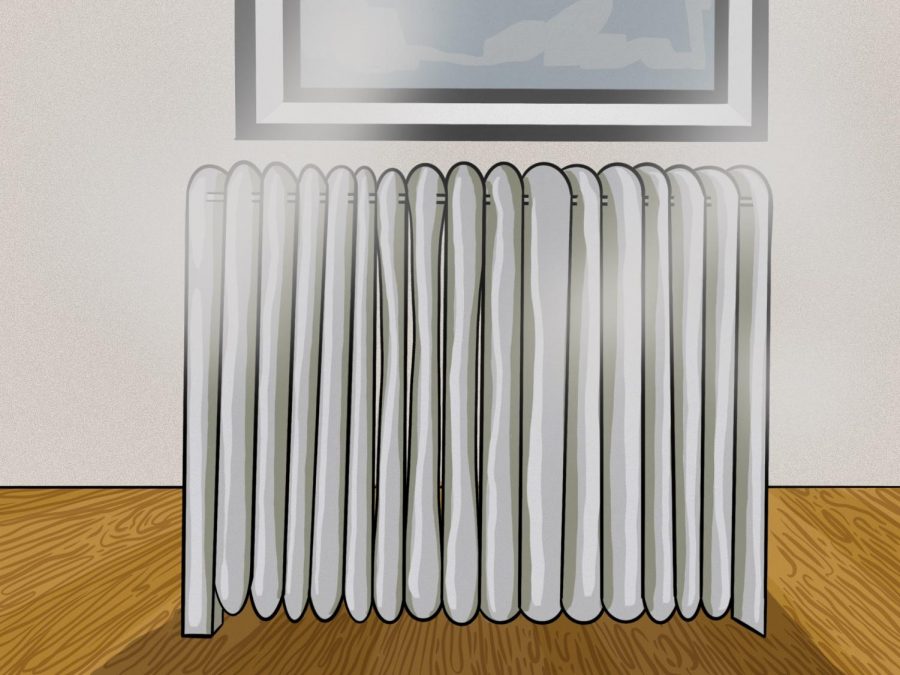Bipolar Disorder: A Radiator and a Window
Between the overbearing heat of a radiator and the cold bursts of a broken windowsill, Abbey attempts to find stability in her New York apartment.
April 27, 2021
The second I heard the radiator creak and groan on the first day of winter, I knew I was screwed. I had never seen a radiator before moving to New York City. I hadn’t given it much thought until that point. It was just the useless thing I stubbed my toe on daily, which is understandable considering the structure was comically large for the glorified closet I called my bedroom. That all changed the first time I brushed against it, felt the sizzle on my skin, and saw the brown burn mark materialize like an omen.
Within minutes, the room grew so swelteringly hot that I jumped out of bed and took off all my clothes for a slight reprieve from the heat. I studied the foreign object and performed minor feats of flexibility to find a control mechanism without burning my exposed flesh. I finally saw a metal bar hidden by the bed frame that resembled a knob and tried to turn it. The only thing I accomplished was getting so many burn marks across my arm that it looked like I had tiger stripes.
I decided to try the window, hoping the 30-degree air outside would balance out the heat of my torture chamber. I was three months into my lease, and I never successfully opened the window. But I had also never given it much effort. Now, I was filled with newfound determination. Naked and burned, I stepped carefully over the radiator, stood on the windowsill, and pulled as hard as I could. It didn’t budge. At this point, I almost cried from frustration. Looking back, I’m just thankful that my spectacular Manhattan view was a dark alley occupied by scattered litter and a family of rats, the only witnesses to my struggle.
I shouldn’t have been surprised by the broken radiator and jammed window. The apartment was an East Village shoebox, turned tinder box that I rented out of desperation sophomore year. The two guys before me, whom the realtor had simply described as “finance bros,” wrecked the place. All the walls had long, deep scratches. Beer bottles sat on every available surface. Food and trash were tucked in the corners. And there was an inescapable smell of sweaty men. But it was a rare affordable option on my teacher’s salary, and the semester started in two days. So I leveraged their destruction to negotiate the rent and committed to making the apartment work.
I had surveyed the damage carefully before signing the lease, and it had seemed manageable at the time. That weekend, my family and I cleaned, repainted and decorated, only complaining every 20 minutes. During my assessment, I hadn’t thought about things like the radiators and windows. Possibly because I was 20 years old, only pretending to be an adult. Maybe because I was too trusting. But mainly because I had never lived without air conditioning. I was accustomed to automatic, calibrated temperature control. Set the dial at a perfect 70 degrees. If it gets too hot, the A/C whirs on, and when the temperature drops, the heater resets the balance. I didn’t realize the privilege of central air until I was living in a room with the proportions of a double bed and no temperature control.
The day I turned in my keys, I wiped all my memories of this apartment. Now, almost two years later, they rushed back when someone asked me about living with bipolar disorder. I struggled to find a combination of words that could describe the periods of highs and lows that disrupted my life. The only image that popped in my head was the scene of my old bedroom with the jammed window and broken radiator, and my six-month battle against these two admirable foes.
This war story is not glorious: when the window didn’t budge that first day, I simply gave up and grew numb to the heat. I folded up my blankets and shoved them in the back of my closet. I developed a mechanism to hang water bottles off my loft bed. I permanently abandoned pajamas. Tossing and turning each night, I was a rotisserie chicken slowly cooking in silence.
I complained about the heat to my friends a few times through quick, dismissive jokes, but I never considered asking them for help. I resolved not to call my parents either, because I didn’t want to admit that my first attempt at real adulthood was failing and that I couldn’t take the heat. Most of all, I truly believed that the radiator was broken, the window was jammed, and there wasn’t a damn thing I could do about it except sweat until spring.
Through sheer luck or an act of God, I finally caught my super in the hallway a few weeks later. I asked if he could fix the radiator and then quickly shut my mouth and held my breath, preparing for his boundary issues and terrible oral hygiene. I was just in time as he leaned over, put his hand on my back, and said he would try, spit hitting my face with each word. Burying my discomfort, I led him in and brought him a glass of water while he gave the radiator a quick inspection. He determined that the dial had been broken off by our favorite finance bros and that he wouldn’t replace it. I gave my best polite smile at his refusal and convinced him to at least break out his toolkit for the window.
Even with the working window, my dreams of temperature equilibrium were killed quickly. The window had to be shoved into the top of the frame to stay open, so I couldn’t crack it. It was so tall that forceful gusts of freezing wind blew through the tight quarters constantly. After that, I regularly abandoned my apartment. I would go to the basement of Bobst Library, curl up in a chair with my winter coat as a blanket and listen to old episodes of podcast The Adventure Zone until my neck ached and eyes drooped.
Eventually, I’d have to venture home. The minute I closed my apartment door, I would strip down to my underwear, throw open the window and snuggle under a single sheet. The mixture of hot and cold air would balance the temperature long enough to fall asleep. The radiator would shut off between two and six in the morning, so I’d wake up each day curled in a ball, surprised I hadn’t caught frostbite.
The first snowfall of the season was the final straw. I gathered all my strength to battle the window. I found a random selection of heavy objects of various heights: a candle whose wick had burnt to a crisp, a wooden pole that appeared one day in my closet, a textbook costing $150 of rent money that I knew I’d never open. Using my toolkit of miscellaneous apartment junk, I’d prop the window open at different heights to control the amount of snowy air rushing through. An admirable attempt at creating a thermostat.
My window strategy was successful, but it required constant maintenance. I could return to my apartment before midnight now, under the condition that I interrupt my schoolwork — or Netflix binge sessions — every 20 minutes to change out my props. Once I had a sliver of hope, though, I was committed to reaching that coveted 70 degrees. I knew that I couldn’t just move apartments, but I could strategize, adjust and acknowledge the amount of work required to achieve room temperature.
I had air conditioning until my sophomore year of college, but I’ve been living without automatic for much longer. My internal temperature system broke at 14 when the first symptoms of my bipolar disorder began to appear. For the last seven years, I have alternated between heat stroke and hypothermia, grasping blindly and desperately for the thermostat. Manic and depressive episodes are more complicated than just hot and cold, but it is a life-long battle for stability and equilibrium. And I’ve gone through the same stages of learning and coping as when I fought my radiator: try, give up, make some improvement, give up again, figure out anything that works and ultimately accept the situation.
High school and college have consisted of kicking wildly at broken space heaters when I’m so depressed that I can’t leave my house for two weeks. It’s involved taking baseball bats to glass windows when I break out of a hypomanic daze and realize I’m about to step into that sketchy tattoo parlor. All the failed attempts at brute force and times when I lost hope were part of the process. The steps to reach the emotional point where I could assemble my unusable candles, talk to my super and just take a deep breath.
So, if you were also wondering what bipolar disorder looks like, it’s standing naked on a dirty windowsill, bare feet inches from a burning radiator, pulling as hard as you can on a broken window, and not giving up.
Email Abbey Whelan at [email protected].





























































































































































